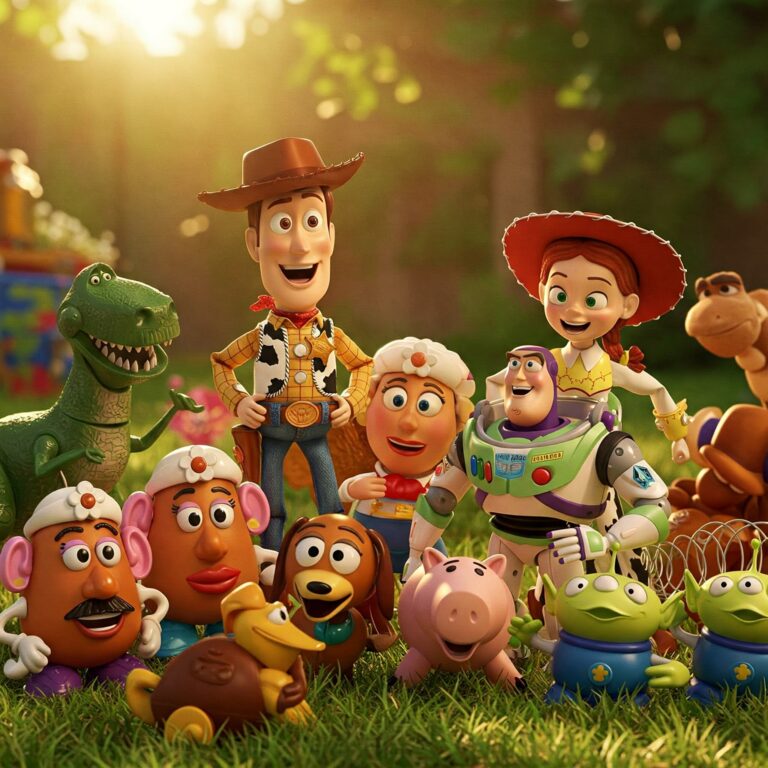Pixar’s Toy Story 3 isn’t just another animated film—it’s a poignant exploration of change, growing up, and the enduring bonds of friendship. Released in 2010, this third installment of the Toy Story series strikes an emotional chord with audiences of all ages, blending humor, nostalgia, and deep emotional storytelling. Through the lens of toys, the movie navigates universal themes of life’s transitions, making it more than just a children’s movie. It’s a narrative that resonates with anyone who has ever faced the challenges of moving on and letting go.
The Story of Letting Go
The plot of Toy Story 3 centers around Andy, the beloved owner of Woody, Buzz, and the rest of his toy gang, who is now preparing to leave for college. The toys face an existential crisis, unsure of their purpose now that their owner is no longer a child. The central conflict arises from their desperate desire to remain relevant in Andy’s life, fearing that they will be discarded and forgotten as he moves on to the next chapter of his life.
The film’s exploration of this poignant moment—leaving childhood behind—is something that resonates with viewers on a deeply personal level.
Toy Story 3 masterfully encapsulates this sentiment, celebrating the purity and happiness of childhood while recognizing the unavoidable journey towards maturity
A Deep Dive into the Toys’ Emotions
One of the most powerful aspects of Toy Story 3 is how the toys are portrayed as not merely inanimate objects, but as characters with their own hopes, fears, and desires. Woody, Buzz, and the others aren’t just toys in the literal sense—they represent all the feelings we have when something or someone we cherish is at risk of being lost. The toys’ fear of abandonment parallels the anxieties many people feel when faced with life changes, like leaving home, changing schools, or moving away from family and friends.
Woody’s leadership and loyalty are tested as he struggles to find a way to reassure the toys that they are still loved, even if they aren’t the focal point of Andy’s world anymore. His journey reflects the internal battle of holding on to the past while trying to make peace with the future—a struggle many can relate to when facing major transitions in life.
Friendship and Loyalty: The Core of the Film
At its heart, Toy Story 3 is a film about friendship and loyalty. As the toys are left in a daycare center, they encounter new characters, including the sinister Lotso, a teddy bear who becomes their antagonist. Lotso, once a beloved toy himself, now represents the bitterness and betrayal of abandonment, offering a stark contrast to the unwavering loyalty of Woody and his friends.
This theme of loyalty is beautifully illustrated in the toys’ refusal to abandon one another, even in the face of fear and uncertainty. Woody, Buzz, Jessie, and the rest of the gang stick together, ensuring that they remain a family, regardless of where they end up. Their loyalty is a reflection of the profound connections we form in our own lives—with family, friends, and experiences—that are worth holding on to, even as circumstances change.
A Symbolic Farewell
One of the most memorable and emotional moments in Toy Story 3 occurs during the film’s climax when Andy says goodbye to his toys. His decision to pass them on to a young girl named Bonnie represents a symbolic act of letting go, one that mirrors the reality of growing up: the moment when you realize that the things you once treasured may have a different purpose in the future, but they will still be loved.
The farewell isn’t just for Andy—it’s for the audience, too. Many viewers watching Toy Story 3 may have had similar experiences in their own lives, of outgrowing certain things or relationships and having to pass them on. Yet, the film teaches that letting go doesn’t mean forgetting. The toys, just like memories, continue to live on in new places and with new people, making new memories that are just as valuable.
The Final Message: Change is Inevitable, but Love Endures
Ultimately, Toy Story 3 conveys a powerful message about the inevitability of change and the importance of embracing it.
The film’s closing scene, with Andy passing on his toys to Bonnie, is both a bittersweet and uplifting moment. It encapsulates the essence of growing up: recognizing that some things must come to an end, but that doesn’t diminish the love we have for them or the impact they’ve had on our lives. The toys may have changed owners, but their bonds are timeless. In the end, Toy Story 3 reminds us that life’s transitions, though challenging, can lead to new beginnings, and the love we share never truly disappears.
Conclusion
Toy Story 3 is more than just an animated film—it’s a heartfelt exploration of life’s transitions, the fears and joys of growing up, and the power of love and loyalty. Its ability to tackle such universal themes with humor and tenderness makes it a masterpiece that resonates with audiences of all ages. Through the eyes of Andy’s toys, we are reminded that although change is inevitable, the bonds we form—whether with people, memories, or things—are what remain constant in our hearts.

